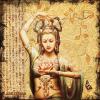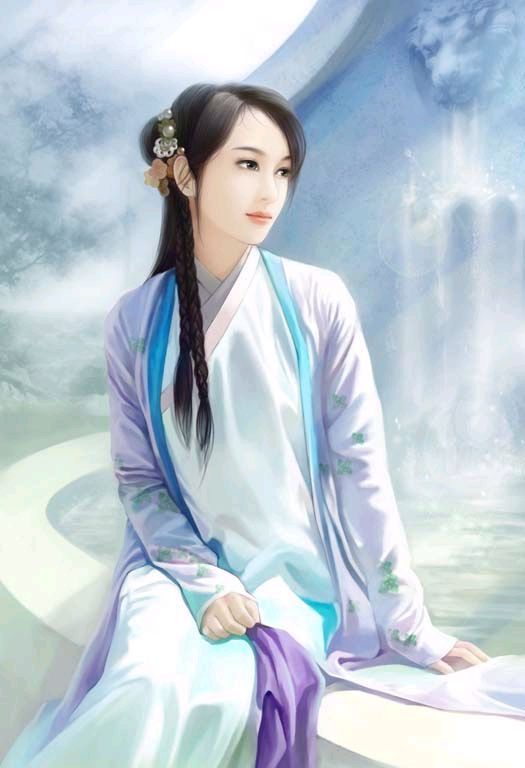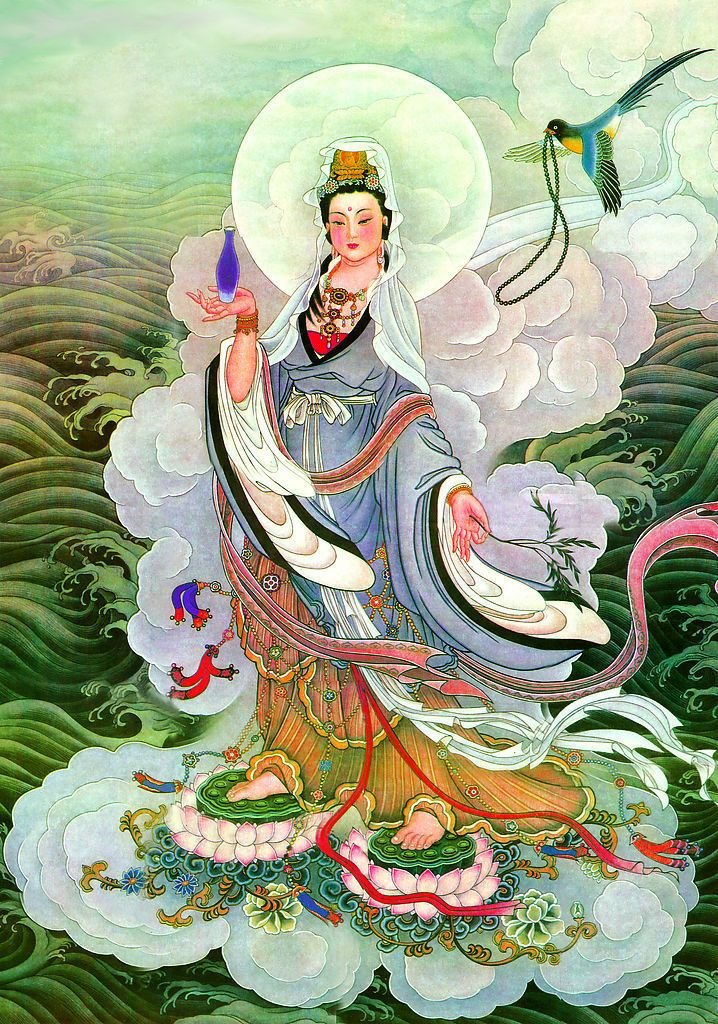 Submitted by Serenity on
Submitted by Serenity on

Mother of Love and Compassion
Bestow your wisdom upon me
Help me see humanity through your eyes
Help me master the love and compassion
that you hold near your heart of Gold
Help me shine like a beacon in the night
and see my reflection in your tear of love
Quan Yin I thank you for your tireless love
and your patience and hope for humanity~
Shanti~ Shanti~ Shanti~
Amen~
There is still much scholarly debate regarding the origin of devotion to the female Bodhisattva Kwan Yin (also known as Quan Shi Yin and Kuan Yin). Quan means to inquire or look deeply into, Shi means the world of people, or generations, Yin means cries. The Boddhisatva of Compassion was inquiring into the suffering (cries) that has come down the generations. Kwan Yin is considered to be the feminine form of Avalokitesvara (Sanskrit), the bodhisattva of compassion of Indian Buddhism whose worship was introduced into China in the third century.
Scholars believe that the Buddhist monk and translator Kumarajiva was the first to refer to the female form of Kwan Yin in his Chinese translation of the Lotus Sutra in 406 A.D. Of the thirty-three appearances of the bodhisattva referred to in his translation, seven are female. (Devoted Chinese and Japanese Buddhists have since come to associate the number thirty-three with Kwan Yin.)
Although Kwan Yin was still being portrayed as a male as late as the tenth century, with the introduction of Tantric Buddhism into China in the eighth century during the T'ang Dynasty, the image of the celestial bodhisattva as a beautiful white-robed goddess was predominant and the devotional cult surrounding her became increasingly popular. By the ninth century there was a statue of Kwan Yin in every Buddhist monastery in China.
Despite the controversy over the origins of Kwan Yin as a feminine being, the depiction of a bodhisattva as both 'god' and 'goddess' is not inconsistent with Buddhist doctrine. The scriptures explain that a bodhisattva has the power to embody in any form--male, female, child, even animal's depending on the type of being he is seeking to save. As the Lotus Sutra relates, the bodhisattva Kwan Shih Yin, "by resort to a variety of shapes, travels in the world, conveying the beings to salvation."

The twelfth-century legend of the Buddhist saint Miao Shan, the Chinese princess who lived in about 700 B.C. and is widely believed to have been Kwan Yin, reinforced the image of the bodhisattva as a female. During the twelfth century Buddhist monks settled on P'u-t'o Shan--the sacred island-mountain in the Chusan Archipelago off the coast of Chekiang where Miao Shan is said to have lived for nine years, healing and saving sailors from shipwreck--and devotion to Kwan Yin spread throughout northern China.
In the Pure Land sect of Buddhism, Kwan Yin forms part of a ruling triad that is often depicted in temples and is a popular theme in Buddhist art. In the center is the Buddha of Boundless Light, Amitabha (Chinese, A-mi-t'o Fo; Japanese, Amida). To his right is the bodhisattva of strength or power, Mahasthamaprapta, and to his left is Kwan Yin, personifying his endless mercy.
In Buddhist theology Kwan Yin is sometimes depicted as the captain of the "Bark of Salvation," guiding souls to Amitabha's Western Paradise, or Pure Land--the land of bliss where souls may be reborn to receive continued instruction toward the goal of enlightenment and perfection. The journey to Pure Land is frequently represented in woodcuts showing boats full of Amitabha's followers under Kwan Yin's captainship. Amitabha, a beloved figure in the eyes of Buddhists desiring to be reborn in his Western Paradise and to obtain freedom from the wheel of rebirth, is said to be, in a mystical or spiritual sense, the father of Kwan Yin. Legends of the Mahayana School recount that Avalokitesvara was 'born' from a ray of white light which Amitabha emitted from his right eye as he was lost in ecstasy. Thus Avalokitesvara, or Kwan Yin, is regarded as the "reflex" of Amitabha further emanation or embodiment of Karuna (compassion), the quality which Amitabha himself embodies in the highest sense. Many figures of Kwan Yin can be identified by the presence of a small image of Amitabha in her crown. It is believed that as the merciful redemptress Kwan Yin expresses Amitabha's compassion in a more direct and personal way and prayers to her are answered more quickly. |
The iconography of Kwan Yin depicts her in many forms, each one revealing a unique aspect of her merciful presence. As the sublime Goddess of Mercy whose beauty, grace and compassion have come to represent the ideal of womanhood in the East, she is frequently portrayed as a slender woman in flowing white robes who carries in her left hand a white lotus, symbol of purity. Ornaments may adorn her form, symbolizing her attainment as a bodhisattva, or she may be pictured without them as a sign of her great virtue.
Kwan Yin's presence is widespread through her images as the "bestower of children" which are found in homes and temples. A great white veil covers her entire form and she may be seated on a lotus. She is often portrayed with a child in her arms, near her feet, or on her knees, or with several children about her. In this role, she is also referred to as the "white-robed honored one." Sometimes to her right and left are her two attendants, Shan-ts-ai Tung-tsi, the "young man of excellent capacities," and Lung-wang Nu, the "daughter of the Dragon-king."
Kwan Yin is also known as patron bodhisattva of P'u-t'o Shan, mistress of the Southern Sea and patroness of fishermen. As such she is shown crossing the sea seated or standing on a lotus or with her feet on the head of a dragon.
Like Avalokitesvara she is also depicted with a thousand arms and varying numbers of eyes, hands and heads, sometimes with an eye in the palm of each hand, and is commonly called "the thousand-arms, thousand-eyes" bodhisattva. In this form she represents the omnipresent mother, looking in all directions simultaneously, sensing the afflictions of humanity and extending her many arms to alleviate them with infinite expressions of her mercy.
Symbols characteristically associated with Kwan Yin are a willow branch, with which she sprinkles the divine nectar of life; a precious vase symbolizing the nectar of compassion and wisdom, the hallmarks of a bodhisattva; a dove, representing fecundity; a book or scroll of prayers which she holds in her hand, representing the dharma (teaching) of the Buddha or the sutra (Buddhist text) which Miao Shan is said to have constantly recited; and a rosary adorning her neck with which she calls upon the Buddhas for succor.
Images of Avalokitesvara, thus then Kwan Yin, is often shown holding a rosary; describing being born with a rosary in one hand --- not unlike a similar story oft repeated regarding the contemporary Japanese Zen master Yasutani Hakuun Roshi --- and a white lotus in the other. It is taught that the beads represent all living beings and the turning of the beads symbolizes that Avalokitesvara is leading them out of their state of misery and repeated rounds of rebirth into Nirvana. Today Kwan Yin is worshipped by Taoists as well as Mahayana Buddhists--especially in Taiwan, Japan, Korea and once again in her homeland of China, where the practice of Buddhism had been suppressed by the Communists during the Cultural Revolution (1966-69). She is the protectress of women, sailors, merchants, craftsmen, and those under criminal prosecution, and is invoked particularly by those desiring progeny. Beloved as a mother figure and divine mediatrix who is very close to the daily affairs of her devotees, Kwan Yin's role as Buddhist Madonna has been compared to that of Mary the mother of Jesus in the West. There is an implicit trust in Kwan Yin's saving grace and healing powers. Many believe that even the simple recitation of her name will bring her instantly to the scene. One of the most famous texts associated with the bodhisattva, the ancient Lotus Sutra whose twenty-fifth chapter, dedicated to Kwan Yin, is known as the "Kwan Yin sutra," describes thirteen cases of impending disaster--from shipwreck to fire, imprisonment, robbers, demons, fatal poisons and karmic woes--in which the devotee will be rescued if his thoughts dwell on the power of Kwan Yin. The text is recited many times daily by those who wish to receive the benefits it promises. |
It is believed that Kwan Yin frequently appears in the sky or on the waves to save those who call upon her when in danger. Personal stories can be heard in Taiwan, for instance, from those who report that during World War II when the United States bombed the Japanese-occupied Taiwan, she appeared in the sky as a young maiden, catching the bombs and covering them with her white garments so they would not explode.
Thus altars dedicated to the Goddess of Mercy are found everywhere--shops, restaurants, even taxicab dashboards. In the home she is worshipped with the traditional "pai pai," a prayer ritual using incense, as well as the use of prayer charts--sheets of paper designed with pictures of Kwan Yin, lotus flowers, or pagodas and outlined with hundreds of little circles. With each set of prayers recited or sutras read in a novena for a relative, friend, or oneself, another circle is filled in. This chart has been described as a "Ship of Salvation" whereby departed souls are saved from the dangers of hell and the faithful safely conveyed to Amitabha's heaven not unlike the Cumeaean Sibyl and her golden bough in Greek mythology.
In addition to elaborate services with litanies and prayers, devotion to Kwan Yin is expressed in the popular literature of the people in poems and hymns of praise.
Devout followers of Kwan Yin may frequent local temples and make pilgrimages to larger temples on important occasions or when they are burdened with a special problem. The three yearly festivals held in her honor are on the nineteenth day of the second month (celebrated as her birthday), of the sixth month, and of the ninth month based on the Chinese lunar calendar. In the tradition of the Great White Brotherhood Kwan Yin is known as the Ascended Lady Master who bears the office and title of "Goddess of Mercy" because she ensouls the God qualities of the law of mercy, compassion and forgiveness. She had numerous embodiments prior to her ascension thousands of years ago and has taken the vow of the bodhisattva to teach the unascended children of God how to balance their karma and fulfill their divine plan by loving service to life and the application of the violet flame through the science of the spoken Word. Kwan Yin preceded the Ascended Master Saint Germain as Chohan (Lord) of the Seventh Ray of Freedom, Transmutation, Mercy and Justice and she is one of seven Ascended Masters who serve on the Karmic Board, a council of justice that mediates the karma of earth's evolutions--dispensing opportunity, mercy and the true and righteous judgments of the Lord to each lifestream on earth. She is hierarch of the etheric Temple of Mercy over Peking, China, where she focuses the light of the Divine |

LEGENDS:
According to one ancient legend her name was Miao Shan, and she was the daughter of an Indian Prince. Youthful and serene, she chose to follow a path of self-sacrifice and virtue, and became a pious follower of Buddha, herself attaining the right to budddhahood but remaining on earth to help mankind. In order to convert her blind father, she visited him transfigured as a stranger, and informed him that were he to swallow an eyeball of one of his children, his sight would be restored. His children would not consent to the necessary sacrifice, whereupon the future goddess created an eye which her parent swallowed and he regained his sight. She then persuaded her father to join the Buddhist priesthood by pointing out the folly and vanity of a world in which children would not even sacrifice an eye for the sake of a parent. Another Miao Shan legend was that the son of the dragon king had taken the form of a carp and was caught by a fisherman and displayed for sale in the market place. Miao Shan sent her servant to buy the fish and released it.
As related in yet another legend Quan Yin was said to be the daughter of a sovereign of the Chou dynasty, who strenously opposed her wish to be a nun, and was so irritated by her refusal to marry that he put her to humiliating tasks in the convent. This means of coercion failed, and her father then ordered her to be executed for disobedience to his wishes. But the executioner, a man of tender heart and some forethought, brought it about that the sword which was to descend upon her should break into a thousand pieces. Her father thereupon ordered her to be stifled. As the story goes, she forthwith went to Hell, but on her arrival the flames were quenched and flowers burst into bloom. Yama, the presiding officer, looked on in dismay at what seemed to be the summary abolition of his post, and in order to keep his position he sent her back to life again. Carried in the fragrant heart of a lotus flower she went to the island of Putuo, near Ningbo. One day her father fell ill and according to a Chinese custom, she cut the flesh from her arms that it might be made into medicine. A cure was effected, and in his gratitude her father ordered her statue to be made "with completely-formed arms and eyes." Owing to a misunderstanding of the orders the sculptor carved the statue with many heads and many arms, and so it remains to this day. (http://www.holymtn.com/gods/kuanyin.htm)

- 17161 reads